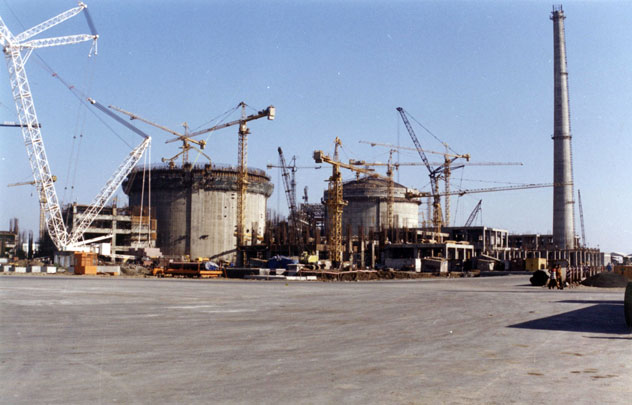SUBCONTINENT:
Safety Concerns: India's Nuclear Plants
Concerns about safety of nuclear power plants are threatening India’s massive investment plans in the sector. After Fukushima disaster in Japan, population around proposed Indian NPP sites have launched protests that are now finding resonance around the country, raising questions about atomic energy as a clean and safe alternative to fossil fuels, writes Siddharth Srivastava.

(Above): The Tarapur Atomic Power Plant
Although Prime Minister Manmohan Singh, the main architect of India’s nuclear program, has repeatedly assured over the last few months that all safety measures will be implemented, many are not buying his arguments.
Locals also have issues about land acquisition rates and suspect rehabilitation promises of the government. There have thus been mass protests against the French-backed 9,900 MW Jaitapur plant in Maharashtra and the 2,000 MW Koodankulam NPP in Tamil Nadu.
Admitting problems, the federal Department of Atomic Energy (DAE) has said there could be a delay in the two projects. “There is opposition to these projects. But we are confident that these would be completed though there would be a little delay,” DAE said in a statement.
Meanwhile, the state government of West Bengal state has refused permission to a proposed 6,000 MW facility near the town of Haripur that intended to host six Russian reactors. Last month, farmers in Haryana violently protested against the setting up of a proposed NPP in the state.
Speaking to TV reporters, S.P. Udhayakumar, a prominent anti-nuclear activist said, “All over the world people are phasing out or canceling nuclear power plants. Electricity should be for the people. It cannot be at the cost of the people.”
Further complicating matters, a Public Interest Litigation (PIL) has been filed against the government’s civil nuclear program at the apex Supreme Court. The PIL specifically asks for the “staying of all proposed nuclear power plants till satisfactory safety measures and cost-benefit analyses are completed by independent agencies.”
It is likely that the court will take up the matter for further hearing given the importance of the matter. Given India’s high population density an accident could be a calamity as happened following the Bhopal gas tragedy in 1984.
India has announced plans to raise nuclear power from current 3% total power generated to 25% by 2050. By 2032 India’s nuclear power capacity has been targeted at 63,000 MW from current 4,500 MW.
Five nuclear parks of 10,000 MW each have been planned. India’s atomic energy market is estimated in the range of U.S. $150-200 billion predicted to rise to U.S. $500 billion if plans are implemented as targeted.
Nuclear Progress. So far India has managed its status as a global “nuclear exception” quite well despite being a non-signatory of international non-proliferation treaties, though Japan and Australia continue to stay away from dealings with it in atomic matters.
Tokyo has said that it wants to conduct a review of safety standards before any agreement with India. Though Australia, a country rich in uranium, has backed India’s nuclear power plans, it has not inked any export deal.
India has, meanwhile, signed civil nuclear deals with the U.S., France, Namibia, Mongolia, Russia, Canada, Angola, Kazakhstan, South Korea, U.K. and the European Atomic Energy Community.
As per India’s enacted laws, liability for accidents has been capped at U.S. $325 million but it can be passed onto the supplier of equipment apart from the operator.
Giving into pressure from America and others, India in November 2010 also signed the Convention on Supplementary Compensation for Nuclear Damage (CSC) that aims to structure a uniform global legal regime to channel liability in the unfortunate event of a nuclear accident.
Meanwhile, state-run entities Uranium Corporation of India Ltd (UCIL) and nodal atomic agency Nuclear Power Corp of India Ltd (NPCIL) have announced plans to pool resources to bid for overseas uranium mines to ensure the availability of the critical fuel.
NPCIL operates all of India’s atomic power stations, while UCIL is involved in mining of uranium. The federal department of atomic energy that oversees both the firms has put in place a joint working framework in which NPCIL will be majority partner, while UCIL will be granted a strategic stake.
On the domestic front India is looking to double uranium production to 800 tons by 2014 from mines in Jharkhand and Andhra Pradesh. Access to uranium imports due to removal of international sanctions has already had an impact on India’s nuclear power generation.
NPCIL reported a big 200% rise in profits in fiscal year 2010-11 ending March 31. NPCIL also achieved its highest ever generation of electrical energy in 2010-2011 and aims to further lift capacity this year.
Concerns Mount. However, concerns about safety of atomic plants following the Fukushima meltdown and land acquisition issues continue to hamper progress.
The Atomic Energy Regulatory Board, the top government agency to ensure safety standards, conducted a safety audit of India’s NPPs a couple of months back. Despite all clear certificates, activists and experts have called for an audit by an independent body.
They say that given the non-transparent nature of India’s state-controlled nuclear energy sector - there is no way to estimate whether safety issues will be carefully followed.
|